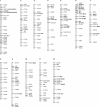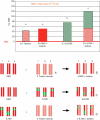Domestication and breeding of tomatoes: what have we gained and what can we gain in the future?
- PMID: 17717024
- PMCID: PMC2759208
- DOI: 10.1093/aob/mcm150
Domestication and breeding of tomatoes: what have we gained and what can we gain in the future?
Abstract
Background: It has been shown that a large variation is present and exploitable from wild Solanum species but most of it is still untapped. Considering the thousands of Solanum accessions in different gene banks and probably even more that are still untouched in the Andes, it is a challenge to exploit the diversity of tomato. What have we gained from tomato domestication and breeding and what can we gain in the future?
Scope: This review summarizes progress on tomato domestication and breeding and current efforts in tomato genome research. Also, it points out potential challenges in exploiting tomato biodiversity and depicts future perspectives in tomato breeding with the emerging knowledge from tomato-omics.
Conclusions: From first domestication to modern breeding, the tomato has been continually subjected to human selection for a wide array of applications in both science and commerce. Current efforts in tomato breeding are focused on discovering and exploiting genes for the most important traits in tomato germplasm. In the future, breeders will design cultivars by a process named 'breeding by design' based on the combination of science and technologies from the genomic era as well as their practical skills.
Figures



Similar articles
-
Genomic variation in tomato, from wild ancestors to contemporary breeding accessions.BMC Genomics. 2015 Apr 1;16(1):257. doi: 10.1186/s12864-015-1444-1. BMC Genomics. 2015. PMID: 25880392 Free PMC article.
-
Genome editing as a tool to achieve the crop ideotype and de novo domestication of wild relatives: Case study in tomato.Plant Sci. 2017 Mar;256:120-130. doi: 10.1016/j.plantsci.2016.12.012. Epub 2016 Dec 28. Plant Sci. 2017. PMID: 28167025 Review.
-
Molecular breeding of tomato: Advances and challenges.J Integr Plant Biol. 2025 Mar;67(3):669-721. doi: 10.1111/jipb.13879. Epub 2025 Mar 18. J Integr Plant Biol. 2025. PMID: 40098531 Free PMC article. Review.
-
Genomic Evidence for Complex Domestication History of the Cultivated Tomato in Latin America.Mol Biol Evol. 2020 Apr 1;37(4):1118-1132. doi: 10.1093/molbev/msz297. Mol Biol Evol. 2020. PMID: 31912142 Free PMC article.
-
Genome of Solanum pimpinellifolium provides insights into structural variants during tomato breeding.Nat Commun. 2020 Nov 16;11(1):5817. doi: 10.1038/s41467-020-19682-0. Nat Commun. 2020. PMID: 33199703 Free PMC article.
Cited by
-
Drought-responsive genes in tomato: meta-analysis of gene expression using machine learning.Sci Rep. 2023 Nov 8;13(1):19374. doi: 10.1038/s41598-023-45942-2. Sci Rep. 2023. PMID: 37938584 Free PMC article.
-
Evidence of cryptic introgression in tomato (Solanum lycopersicum L.) based on wild tomato species alleles.BMC Plant Biol. 2012 Aug 7;12:133. doi: 10.1186/1471-2229-12-133. BMC Plant Biol. 2012. PMID: 22871151 Free PMC article.
-
Bin mapping of tomato diversity array (DArT) markers to genomic regions of Solanum lycopersicum × Solanum pennellii introgression lines.Theor Appl Genet. 2012 Mar;124(5):947-56. doi: 10.1007/s00122-011-1759-5. Epub 2011 Dec 13. Theor Appl Genet. 2012. PMID: 22159755 Free PMC article.
-
Exploring New Alleles Involved in Tomato Fruit Quality in an Introgression Line Library of Solanum pimpinellifolium.Front Plant Sci. 2016 Aug 17;7:1172. doi: 10.3389/fpls.2016.01172. eCollection 2016. Front Plant Sci. 2016. PMID: 27582742 Free PMC article.
-
Leaf shape is a predictor of fruit quality and cultivar performance in tomato.New Phytol. 2020 May;226(3):851-865. doi: 10.1111/nph.16403. Epub 2020 Feb 11. New Phytol. 2020. PMID: 31880321 Free PMC article.
References
-
- Alpert KB, Grandillo S, Tanksley SD. fw 2·2: a major QTL controlling fruit weight is common to both red- and green-fruited tomato species. Theoretical and Applied Genetics. 1995;91:994–1000. - PubMed
-
- Bai Y, Lindhout P. New Challenges for Durable Resistance Breeding in Tomato. Proceedings of the XVth meeting of the Eucarpia Tomato Working Group; 20–23 September, 2005; Bari, Italy. 2005.
-
- Bai Y, Huang CC, Van der Hulst R, Meijer-Dekens F, Bonnema G, Lindhout P. QTLs for tomato powdery mildew resistance (Oidium lycopersici) in Lycopersicon parviflorum G1·1601 co-localize with two qualitative powdery mildew resistance genes. Molecular Plant Microbe Interaction. 2003;16:169–176. - PubMed
-
- Bai Y, Feng X, Van der Hulst R, Lindhout P. A set of simple PCR markers converted from sequence specific RFLP markers on tomato chromosomes 9 to 12. Molecular Breeding. 2004;13:281–287.
Publication types
MeSH terms
LinkOut - more resources
Full Text Sources
Other Literature Sources

